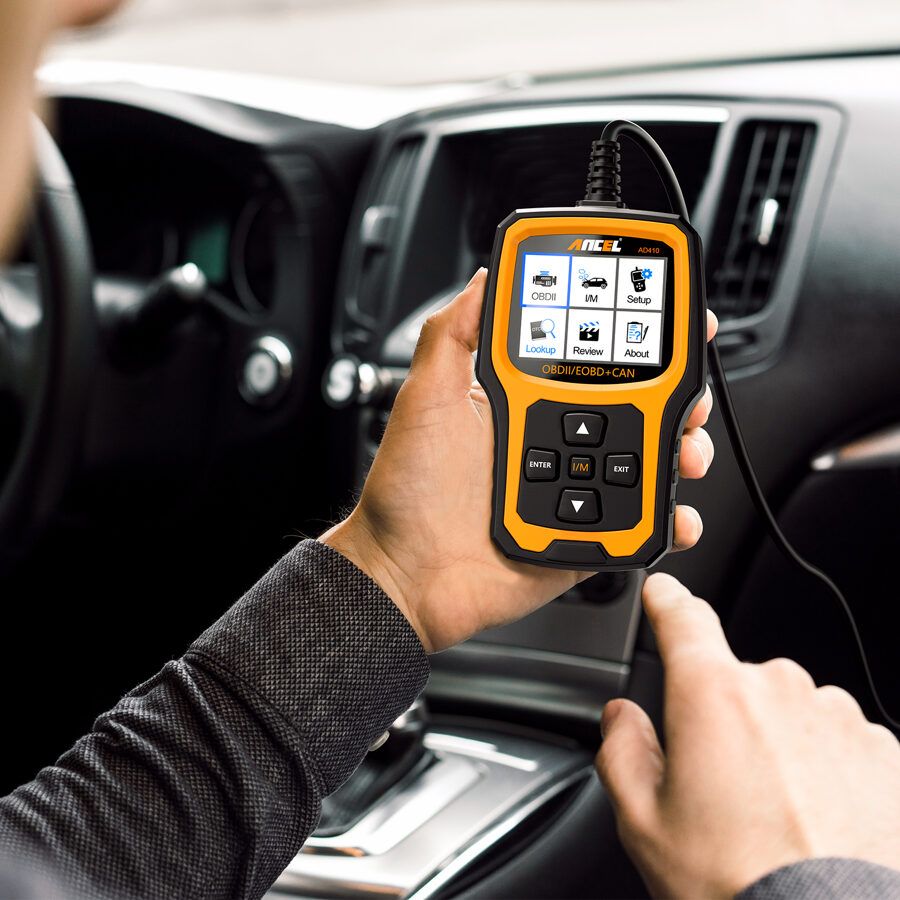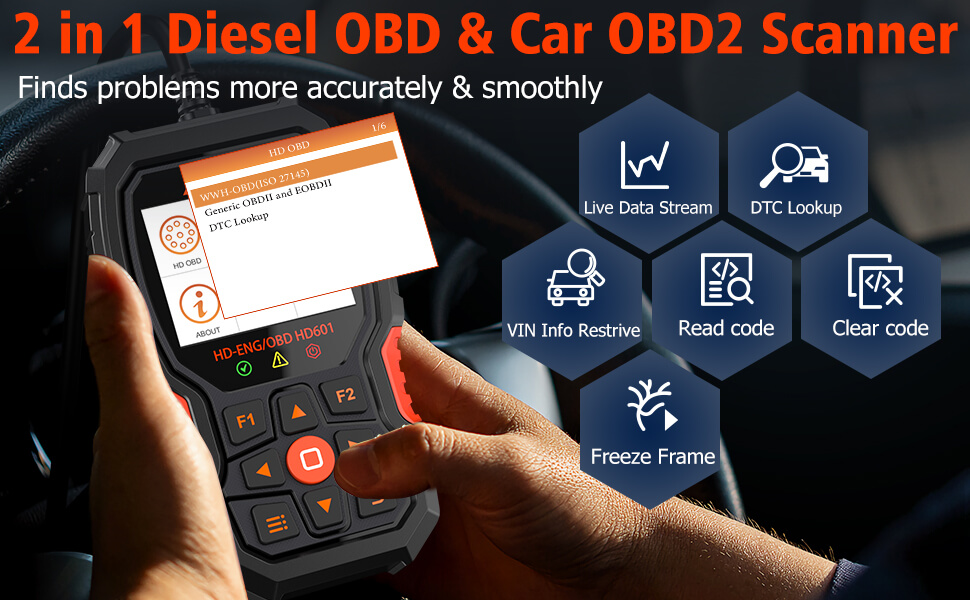How to Use Ancel OBD Scanner for Car Diagnostics
Are you a beginner in the field of automotive diagnostics? Would you like to learn how to effectively use an OBD scanner to diagnose car problems? Look no further! In this comprehensive guide, we'll walk you through the basics of OBD scanners and provide step-by-step instructions on how to use the popular Ancel OBD scanner for car diagnostics. After reading this article, you will have the knowledge and confidence to use an OBD scanner to diagnose and troubleshoot common car problems.

Introduction to OBD Scanners
Modern vehicles are equipped with sophisticated onboard computer systems that monitor various components and systems to ensure optimal performance. An On-Board Diagnostics (OBD) system is a standardized computer system that helps detect and report any malfunctions or issues in a vehicle. OBD scanners are diagnostic tools used to interface with the OBD system and retrieve valuable diagnostic information.
Understanding On-Board Diagnostics (OBD)
The OBD system in your car continuously monitors various parameters such as engine performance, fuel efficiency, emission levels, and other vital components. It generates fault codes, also known as Diagnostic Trouble Codes (DTCs), whenever it detects a problem. These fault codes provide valuable information about the specific issue affecting your vehicle.
Benefits of Using an OBD Scanner
Using an OBD scanner offers several advantages for both professional mechanics and car owners. Here are some key benefits:
- Cost-Effective Diagnostics: OBD scanners help you identify issues quickly, enabling you to avoid costly trips to the mechanic for minor problems.
- Time-Saving: With an OBD scanner, you can quickly retrieve diagnostic trouble codes and pinpoint the source of the problem, saving you time in the troubleshooting process.
- Empowerment: By understanding the diagnostic codes, you gain insight into your vehicle's condition and can make informed decisions regarding repairs or maintenance.
- Emission Testing: OBD scanners are essential for emission testing, ensuring that your vehicle meets environmental regulations.
Getting Started with the Ancel OBD Scanner
The Ancel OBD scanner is a popular choice among car enthusiasts and professionals due to its reliability and user-friendly interface. Follow these steps to get started:
- Step 1: Verify Compatibility: Ensure that the Ancel OBD scanner is compatible with your vehicle's OBD system. Check the scanner's user manual or the manufacturer's website for compatibility information.
- Step 2: Power Up the Scanner: Connect the OBD scanner to the vehicle's OBD port. The OBD port is typically located under the dashboard, near the steering wheel. Power up the scanner by turning the vehicle's ignition to the "On" position.
- Step 3: Navigate the Scanner Menu: Once the scanner is powered on, navigate through the menu using the arrow keys or touch screen, depending on the scanner model.
- Step 4: Establish Connection: Select the "Scan" or "Diagnose" option on the scanner to establish a connection with the vehicle's OBD system.
Connecting the OBD Scanner to Your Car
To connect the Ancel OBD scanner to your car, follow these simple steps:
- Step 1: Locate the OBD Port: Find the OBD port in your vehicle, which is usually located beneath the steering wheel or near the driver's side footwell.
- Step 2: Plug in the Scanner: Insert the Ancel OBD scanner's connector into the OBD port. Ensure a secure connection.
- Step 3: Power On the Scanner: Turn on the ignition key without starting the engine. This will power on the scanner and establish a connection with the car's OBD system.
- Step 4: Wait for Communication: Wait for the scanner to establish communication with the OBD system. This may take a few seconds.
Using the Ancel OBD Scanner for Basic Diagnostics
The Ancel heavy duty truck scanner provides a range of basic diagnostic functions to help you identify car problems. Follow these steps to perform basic diagnostics:
- Step 1: Read Trouble Codes: Once the scanner establishes communication with the OBD system, select the "Read Codes" option on the scanner's menu. The scanner will retrieve any stored trouble codes from the vehicle's computer.
- Step 2: Interpret the Codes: Refer to the scanner's user manual or the included code library to interpret the retrieved trouble codes. The codes will provide information about the specific problem areas.
- Step 3: Research the Codes: Utilize online resources or car repair manuals to research the trouble codes further. This will help you understand the root cause of the issue and potential solutions.
- Step 4: Take Necessary Actions: Based on the code interpretation and research, take appropriate actions to resolve the identified problems. This may involve repairs, component replacements, or seeking professional assistance.

Interpreting OBD Scanner Trouble Codes
OBD scanners provide standardized trouble codes that consist of alphanumeric characters. Here's a basic breakdown of the trouble codes:
- P0xxx: Powertrain Codes (Engine and Transmission)
- C0xxx: Chassis Codes (ABS, ESP, Suspension)
- B0xxx: Body Codes (Airbags, Comfort Systems)
- U0xxx: Network Communication Codes (CAN bus, modules)
Understanding the trouble codes will help you narrow down the problem area and facilitate efficient troubleshooting.
Clearing Trouble Codes and Resetting the Check Engine Light
After resolving the identified issues, you may want to clear the trouble codes and reset the Check Engine Light. Follow these steps:
- Step 1: Select "Clear Codes": Access the scanner's menu and select the "Clear Codes" or "Erase Codes" option.
- Step 2: Confirm Clearing: Confirm the action when prompted. Note that clearing the codes will also reset the Check Engine Light.
- Step 3: Turn Off the Ignition: Turn off the ignition key and wait for a few seconds before starting the engine again.
- Step 4: Verify Clearing: Restart the vehicle and check if the Check Engine Light remains off. If it does, the trouble codes have been successfully cleared.
Advanced Features of the Ancel OBD Scanner
The Ancel OBD scanner offers advanced features that can enhance your diagnostic capabilities. Some of these features include:
- Live Data Stream: View real-time data from various sensors and systems, such as engine RPM, coolant temperature, oxygen sensor readings, and more.
- Graphing Function: Graphically analyze data streams to identify patterns or abnormalities.
- Vehicle Information: Retrieve detailed information about your vehicle, including VIN (Vehicle Identification Number), calibration IDs, and more.
- Oxygen Sensor Testing: Monitor the performance of oxygen sensors to ensure optimal fuel efficiency and emission control.
OBD Scanner Maintenance and Updates
To keep your Ancel OBD scanner functioning optimally, follow these maintenance tips:
- Regular Updates: Check for firmware and software updates from the manufacturer's website and update your scanner accordingly. This ensures compatibility with the latest vehicle models and improved functionality.
- Clean Connections: Periodically clean the OBD scanner's connector and the vehicle's OBD port to maintain a good connection. Use compressed air or a soft brush to remove any dirt or debris.
- Safe Storage: Store the OBD scanner in a clean and dry place, protecting it from extreme temperatures and humidity.
- Battery Maintenance: If your scanner has a built-in battery, follow the manufacturer's instructions for battery maintenance and charging.
Frequently Asked Questions (FAQs)
Q1: Can I use an OBD scanner on any car?
OBD scanners are compatible with most vehicles manufactured after 1996, as they are equipped with the standardized OBD-II system. However, it's always recommended to verify the compatibility of your scanner with your specific vehicle make and model.
Q2: Are OBD scanners difficult to use for beginners?
OBD scanners are designed to be user-friendly, with intuitive menus and instructions. With a bit of practice, beginners can quickly learn how to use them effectively.
Q3: Can an OBD scanner fix car issues?
OBD scanners are diagnostic tools and cannot fix car issues on their own. However, they provide valuable information that helps identify the problem areas, enabling you or a professional mechanic to perform the necessary repairs or maintenance.
Q4: How often should I use an OBD scanner?
It is good practice to perform periodic diagnostics with an OBD scanner, especially if you notice unusual behavior or the check engine light comes on. Regular use can help catch potential problems early and prevent major problems.
Q5: Can I pass the emissions test with an OBD scanner?
Yes, OBD scanners are essential for emissions testing, as they provide information about emissions-related systems and monitor readiness. They help ensure your vehicle meets the required emissions standards.
Conclusion
Congratulations! You have finished reading this beginner's guide to OBD scanners. We hope this article has given you valuable insight into the world of automotive diagnostics and how to use Ancel OBD scanners effectively. When using the scanner and interpreting fault codes, remember to follow the steps outlined. With practice and knowledge, you'll be able to proficiently diagnose and troubleshoot common automotive problems. So start using your Ancel car diagnostic scanner and enjoy a smoother, more informed car buying experience.